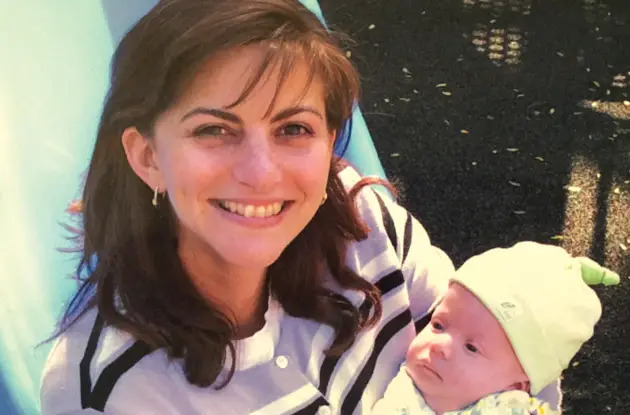Stacey Follman, a Westchester mom, had a healthy pregnancy, with everything progressing normally and as she and her doctors expected. But when her son Aaron Ross Follman was born on May 21, 2002, and taken to the neonatal intensive care unit immediately, she knew something obviously was wrong. Aaron had a seizure shortly after delivery and hardly moved or cried. It took the doctors 10 days to figure out he suffered from a rare congenital disorder called Zellweger Syndrome. The doctors expected Aaron to have a life expectancy of about 12 months. He died just a few days short of his 8-month birthday on Jan. 16, 2003.
Nothing can prepare parents for losing a baby. Follman believed Aaron would live longer despite being told he probably would die within a year. “We were buying him new pajamas because he was growing,” she says. “We had faith that he was going to live until the day he died.”
It’s a heartbreak that will never go away. Most parents thankfully do not have to face the horrors of losing a baby, and it’s difficult to imagine the pain endured by that small minority of parents who, like Follman, never see their babies make it to their 1st birthday.
Despite its advanced health care system, America still lags behind other industrialized nations in its infant mortality rate (IMR), which is defined as “the death of a child under the age of 1—from birth through 364 days,” explains Deborah E. Campbell, M.D., the director of neonatology at The Children’s Hospital at Montefiore in the Bronx. The reasons for this are complicated and varied, and with October designated as Pregnancy and Infant Loss Awareness Month, it’s a moment to try to understand why some babies die in the first year, how our area compares to the nation as a whole, and what parents can do to minimize the risk.
Understanding the IMR Statistics
Experts break down the IMR into two categories: neonatal mortality, which occurs the first 28 days after birth, and post-neonatal mortality (29-364 days). “Most infant deaths take place in the neonatal period,” says Dr. Campbell, who lost a baby herself many years ago. The IMR does not include miscarriages or stillbirths.
Although the U.S. is a developed nation, 25 other industrialized nations do a better job at keeping babies alive in the first year of life. While these statistics are startling for expectant parents, the relatively good news for New Yorkers is the IMR in New York City and the surrounding areas is at a historic low. In 2013, the most recent year IMR statistics are available, our area’s IMR averaged nearly 30 percent lower than the overall U.S. rate of 6 deaths per 1,000 live births.
Local Infant Mortality Rates |
|
The following are IMR expressed per 1,000 live births in 2013, the most recent year statistics are available: Bronx: 5.1 Sources: NYC Department of Health; March of Dimes Perinatal Stats; health.ny.gov |
The three leading causes of infant death in our region were prematurity, birth defects or congenital diseases—such as Aaron’s Zellweger Syndrome—and cardiovascular disease. Other infant death causes include babies born to a mother with an underlying medical condition and babies who die from sudden infant death syndrome or accidental suffocation while sleeping, usually with other family members, Dr. Campbell explains.
RELATED: Find Pregnancy and Baby Health Services
Disparities in Infant Mortality Rates
Infant death rates vary greatly depending on the mother’s race and ethnicity. The infant mortality rate for African-American infants in the metropolitan area was 8.3 per 1,000 births versus a rate of 3.0 among white infants in 2013. Infant mortality rates were also higher for Puerto Ricans (4.8) and other Hispanics and Latinas (4.3). Infant mortality rates likewise differ by socioeconomic status, with high-poverty areas such as the South Bronx reporting 1.9 times greater rates—5.2 per 1,000 live births compared to 2.8 in higher-income places such as the Upper East Side or Scarsdale. Dr. Campbell notes that years ago certain areas of Brooklyn had a much higher IMR but with gentrification those numbers have been dropping significantly.
David Bateman, M.D., an attending neonatologist and professor of pediatrics at Columbia University Medical Center, has been treating newborns for more than four decades. In the 1980s, he practiced at Harlem Hospital and witnessed firsthand how the trifecta of AIDS, crack, and syphilis in Harlem was wreaking havoc on the IMR rates in that neighborhood. “In the past 30 years, IMR in New York City has had a threefold drop,” Dr. Bateman says. “You can look at changes in medical care, you can look at access to medical care, but it is all about poverty and the changing demographics of NYC. Our IMR has been dropping because you don’t have the same concentration of desperately poor people in NYC that you used to.”
IMR tends to drop as doctors discover new ways to save infants’ lives, such as the increased availability of clean water in the first half of the 20th century and the advent of neonatal intensive care units in the 1960s and early ’70s. However, Dr. Bateman cautions, “until the social and economic problems are taken care of, the problem of high IMR is not going to go away.”
There have been many studies looking at the inequity of health care delivery and how that correlates with infant mortality. “There are still women who get late or no prenatal care or have trouble accessing prenatal care, particularly minority women,” Dr. Campbell says. While the teen pregnancy rate has dropped almost 50 percent in recent years, babies born to women younger than 20 have higher infant mortality rates and their mothers are less likely to have had prenatal care. On the flip side, many studies have shown that women with advanced maternal age (defined by doctors as older than 35) also have babies who are at a higher risk of infant mortality.
Other factors also play a role. Babies born to obese mothers, for instance, face higher infant mortality rates, as obesity can lead to health problems in the mother such as hypertensive disorders or preeclampsia, putting her baby at a higher risk of complications for pre-term or low birth weight. And some experts believe assisted reproductive technology may play a role in infant mortality, especially when several embryos have been implanted, Dr. Campbell says.
Minimizing the Risk of Infant Mortality
While there is no way to eliminate the risk of infant death, pregnant women can take steps to minimize the danger, starting with getting prenatal care; moms who do not receive prenatal care have babies that are at a higher risk of infant mortality. Doctors prescribe prenatal vitamins, recommend exercises and offer instruction on healthy pregnancy diets, and monitor the mom and baby to help ensure a successful pregnancy, delivery, and infancy.
In addition, tests during the prenatal period can pinpoint a fetus’ growth and show if there are any genetic defects or other problems in utero. Doctors are regularly developing more advanced tests that can screen for a multitude of genetic disorders. When Aaron Follman was born 15 years ago, there were no genetic tests for his disease, but today, with the help of genetic counseling, expectant parents can now test for that and many other congenital diseases. Armed with this information, doctors can sometimes perform interventions in utero or soon after birth to help the baby, while parents can make informed decisions about whether to continue the pregnancy or how to care for the baby after birth.
As terrifying as it is to prepare for the worst, expectant parents should learn about the differences in NICUs and what types of services are offered at different hospitals in the area. NICUs are rated on levels from 1-4, with Level 1 offering basic newborn care for healthy infants and Level 2 offering advanced newborn care for babies born at 32 weeks or more or those recovering from more serious conditions. Levels 3 and 4 are for the most complex cases, with Level 3 providing care for babies born at less than 32 weeks who may require access to pediatric sub-specialists or babies who are born with critical illnesses. Level 4 NICUs provide the most acute care. These nurseries are located in hospitals that can provide surgical repair of complex congenital or acquired conditions. If the delivery is expected to be complicated or the baby is determined to be high-risk, having access to a level 3 or 4 NICU is key.
Once a baby is born, doctors obviously do everything they can to keep her healthy, and a lot of medical research focuses on keeping babies alive in this neonatal period. Parents can also take steps to maintain their baby’s overall health, including getting children immunized on schedule, experts say.
Ensuring a safe sleep environment is also essential, as many babies die during their first year because of SIDS or suffocation while sleeping. The American Academy of Pediatrics recommends parents follow the ABCs of safe sleep: Alone, On Back, In a Crib. That translates to having babies share a room with their parents if possible, but not in the same bed. And babies should always be put to sleep on their backs.
 All photos courtesy Stacey Follman |
|
Aaron Follman and his mom, Stacey Follman, from his too-short life. Aaron died from a genetic disorder days shy of his 8-month birthday. |
‘I Don’t Want Aaron to be Forgotten’
For those who have endured the loss of a baby, the grieving process varies from individual to individual. Family, friends, and community members are left to try to offer some comfort to those parents; however, even the best-intentioned efforts can sometimes cause the mourning parents pain and leave them feeling lonely.
“Our society is very uncomfortable with baby loss, so people express their sympathy with platitudes such as, ‘You are young, you can have another kid,’ which really minimizes the loss,” says Marianne Walsh, a grief counselor at the Maggie Rose Perinatal Bereavement Program at Northern Westchester Hospital in Mount Kisco. Dr. Campbell echoes that sentiment, saying she often hears people say to the parents, “At least the baby didn’t live long—you didn’t have time to get too attached.”
Current research on grief shows there are four stages bereaved parents generally face, Walsh says: (1) Accepting the death, (2) working through the feelings of pain and grief, (3) adjusting to life without their beloved child, and (4) continuing a bond with their baby, which often happens by memorializing their lost loved one, whether it be through a ritual or by joining or starting a group.
Follman decided to take that last route after Aaron died. To raise awareness of the disease that killed him, she created a nonprofit called the Aaron Ross Foundation. “I want people to know about Zellweger Syndrome and I want Aaron’s name to live on and for our nonprofit to outlive me,” Follman says. “I don’t want Aaron to be forgotten.”
The process of memorializing or honoring a deceased baby has changed dramatically during recent years with the help of social media and groups such as Now I Lay Me Down to Sleep, a nonprofit that provides professional-quality photographers free of charge to grieving parents to take photos of their child prior to the funeral. This remembrance photography can be a very powerful part of the healing process for grieving parents.
The grieving process is not a linear progression, Walsh says, and the needs of the bereaved parents will fluctuate over time. “I often use the analogy of a roller coaster. After a while it [the grief] becomes like a kiddie roller coaster; the highs aren’t so high and the lows aren’t so low.” It is impossible to predict the duration of grieving from person to person. “Bereavement groups provide wrap-around support because when a baby dies the world stops for these families,” Walsh says.
Follman says she found it very difficult to be in a bereavement group with other parents who had lost older children. For her and her husband, individual counseling was a better option, and the doctors at Mount Sinai Hospital, where she delivered, were able to put them in touch with other couples who had babies with ZS. “They were the only ones who truly understood us,” she says.
After Aaron died, Follman says she felt very selfish for a long time. Despite knowing that Aaron had no quality of life, she wondered if she did the right thing by signing a “do not resuscitate” order. “In hindsight, I know I gave everything to my child. His whole life he knew people loved him,” she now says.
Dr. Campbell says many parents drift in and out of support groups, often showing an elevated need for help around birthdays, the anniversary of their due dates, or family holidays. “After the funeral, everyone is around but then the world wants everything to go back to normal,” she says. “People are worried to talk to the mother about it because they don’t want her to dwell on the death. But as a mother, you are going to think about that loss every single day. And then there comes a day that you don’t think about it and then you realize you are more upset, so you beat yourself up that you forgot about your baby.”
No matter how short a life the child lived, that time was still important and marks the life of a human being. “Having lost a child, even if it was a newborn or baby, still means you are a parent,” Dr. Campbell says. “You may not have that child with you physically in your arms anymore but you are still a parent and that child will always be in your head and in your heart.”
RELATED: Find Pregnancy and Baby Advice and Tips






















